Billionton Systems UBTC1 Bluetooth USB Dongle User Manual 1
Billionton Systems, Inc. Bluetooth USB Dongle Users Manual 1
Contents
Users Manual 1

USB / PCMCIA / CF Adapter
Manual and
Application note
1.4

Index
INTRODUCTION 1
CHAPTER1
Package 2
Features 2
Specifications 2
Mechanics 3
Certification 4
Environmental Operating Ranges 4
Power Consumption 4
LED Indication 4
Drivers support 4
CHAPTER2
Setup for Windows 98/2000/ME/XP 6
Setup for Mac 13
CHAPTER3
Application note for Windows
98SE/ME/2000/XP 14
Icons used for Bluetooth devices and
services 14
Network sharing setting for Windows 17
File transfer setting for Windows 26
Dial-up networking setting for Windows 28
FAX setting 31
PIM Item Transfer setting 32
PIM Synchronization setting 34
Serial Port setting 36
ActiveSync setting 37
Audio Gateway setting for windows 40
Personal area network setting for
Windows 42
CHAPTER4
Setup for PocketPC2000 & PocketPC2002
48
Configuring BTW-CE 54
Network sharing setting for WinCE 63
File transfer setting for WinCE 68
Dial-up networking setting for WinCE 72
Serial Port setting for WinCE 81
ActiveSync setting for WinCE 82
Hosting a Personal area network 86
CHAPTER5
How to pair with my mobile phone 89
How to pair with 6310 89
How to pair with 8910 90
How to pair with Ericsson T39m 91
How to pair with Ericsson T68 92
How to sync with Ericsson T68 via
XTNDConnectPC 93
How to sync with Nokia 7650 via Nokia PC
Suite for 7650 103
How to establish Bluetooth connection
with Nokia 3650 109
How to connect to Ericsson P800 via
serial port 120
How to setup Hyper Terminal for
Bluetooth transfer 153
How to HotSync with Palm Bluetooth SDIO
and Tungsten T 159
How to dial-up from Palm Tungsten T to
my PC’s modem to surf the internet 162
Sending FAX VIA mobile phone with
WinFAXPro 163
Bluetooth Printing to HP DeskJet 995c 168
CHAPTER6
Application note for Mac O.S. 172
TROUBLESHOOTING
Troubleshooting 182

1
Introduction
Bluetooth is an open specification for a cutting-edge technology that enables short-range
wireless connections between desktop and laptop computers, personal digital assistants,
cellular phones, printers, scanners, digital cameras and even home appliances — on a
globally available band (2.4GHz) for worldwide compatibility. In a nutshell, Bluetooth
unplugs your digital peripherals and makes cable clutter a thing of the past. Now you can
connect your PDA or PC to Bluetooth™ enabled mobile phone with this Bluetooth™
adapter.
You can access e-mail & Internet no matter where you are with just a little help from your
Bluetooth™ mobile phone.
Plus, when you are back in the office, you can hook yourself up to your office network as
well as communicate with other Bluetooth™-enabled devices.
i

2
Chapter1
Package
One Bluetooth adapter
One driver and software disk
This user manual
Features
Bluetooth v1.1 compliant
USB Bluetooth adapter support full speed USB v1.1 Interface.
CF Bluetooth adapter complies with CompactFlash type I Interface.
PCMCIA Bluetooth adapter complies with PC Card Standard, including PCMCIA
release 2.1 and JEIDA 4.x standards.
Wireless communication within a radius of 32 Feet (10 Meters) for Class 2 Bluetooth
devices.
Wireless communication within a radius of 328 Feet (100 Meters) for Class 1
Bluetooth devices.
Connect up to 7 different Bluetooth enabled devices
Encryption and authentication to ensure safe, secure communications
Low power consumption
Specifications
Main chip: CSR BlueCore 02
Protocol: Bluetooth 2.4 GHz ISM band frequency hopping
Data Rate: 721 Kbps
Connect up to 7 devices in a Piconet
Antenna: Integrated inside the adapter
0dBm(Class 2) Bluetooth radio:
Connection within a range of up to 32 feet (10 meters)
1

3
Class1 Bluetooth radio:
Connection within a range of up to 328 feet (100 meters)
Sensitivity: -80dbm at 0.1% Bit Error Rate (BER)
Security: encrypted link, authentication
Bluetooth profile support includes:
Generic Access Profile (GAP)
Serial Port Profile (SPP)
Service Discovery Application Profile (SDAP)
Generic Object Exchange Profile (GOEP)
Object Push Profile (OPP)
File Transfer Profile (FTP)
Dial-up Network Profile (DUN)
LAN Access Profile (LAP)
Fax Profile (FAX)
Synchronization Profile
Headset Profile
Personal Area Network (PAN)
Human Interface Device (HID)
Hardcopy Cable Replacement Profile (HCRP)
Mechanics
USB Bluetooth Dimension:
58.6 x 19.8 x 8.1 mm (L x W x H) (for Class 2)
72.2 x 29.8 x 8.5 mm (L x W x H) (for Class 1 width including external antenna)

4
CF Bluetooth Dimension:
47.3 x 42.9 x 4.58 mm (L x W x H)
PCMCIA Bluetooth Dimension:
86 x 54 x 5 mm (L x W x H)
Certification
FCC, CE, BQB
Environmental Operating Ranges
·Temperature: 0 ~ 50%
·Humidity: 10 ~ 90%
Power Consumption
USB Bluetooth:
Typical: 40mA/5V
Maximum: 90mA/5V
CF Bluetooth:
Typical: 40mA/3.3V
Maximum: 90mA/3.3V
PCMCIA Bluetooth:
Typical: 70mA/5V
Maximum: 210mA/5V
Idle: 25mA/5V
LED Indication
CF adapter LED: Power on, Activity
PCMCIA adapter LED: Activity
Drivers support
USB Bluetooth:

5
Windows 98SE, Me, 2000, XP, MAC O.S. 10.2.x
CF Bluetooth:
Windows 98SE, Me, 2000, XP, PPC2000, PPC2002, PPC2003
PCMCIA Bluetooth:
Windows 98SE, Me, 2000, XP
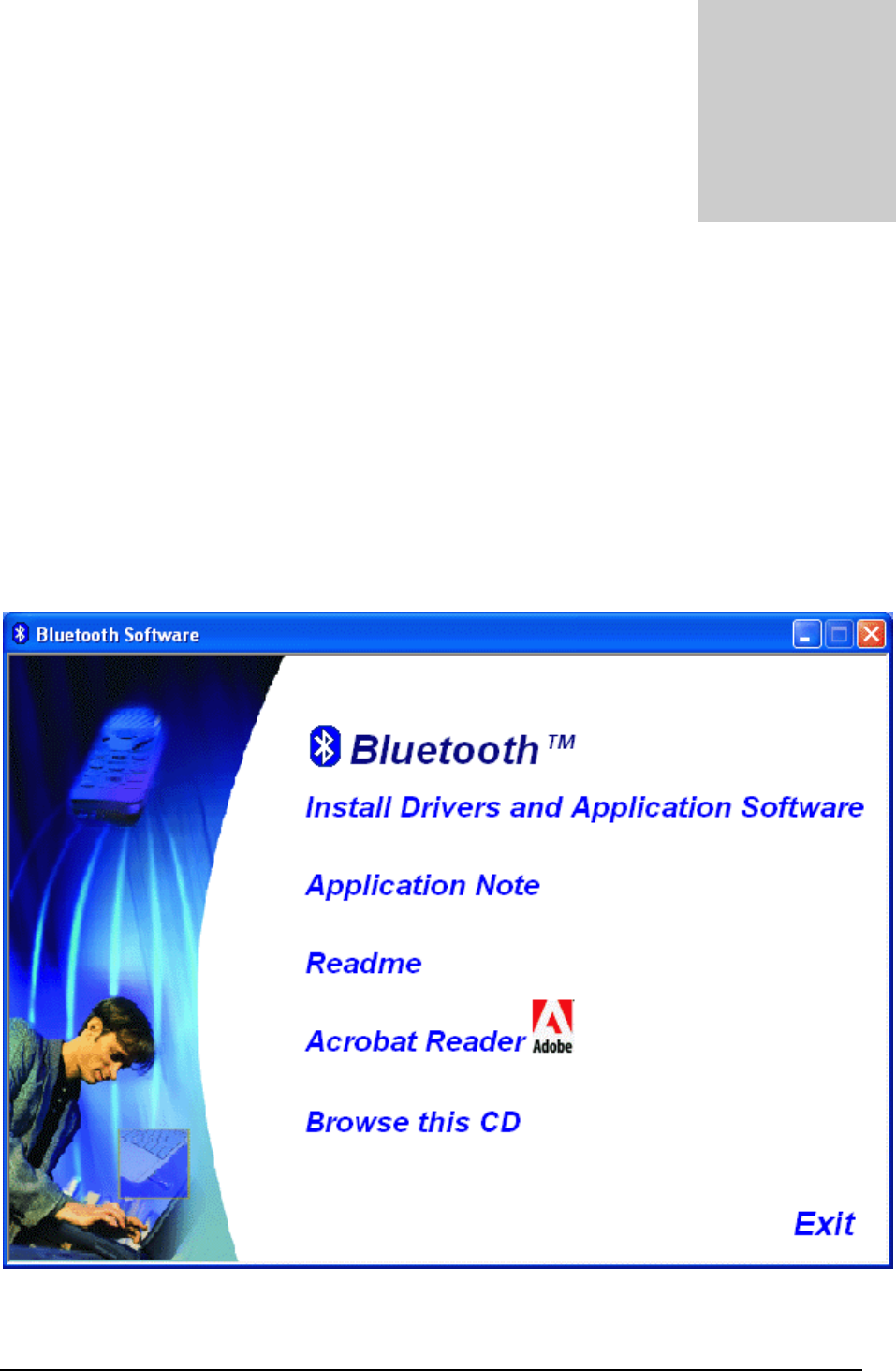
6
Chapter2
Setup for Windows 98SE/2000/ME/XP
Installing Bluetooth software for Windows
(1) Place installation CD into PC and the setup menu should launch automatically.
If the setup menu does not launch automatically, use Windows Explorer to navigate to the
appropriate CD-ROM drive and run "bsetup".
(2) Select “Install Drivers and Application Software”.
2
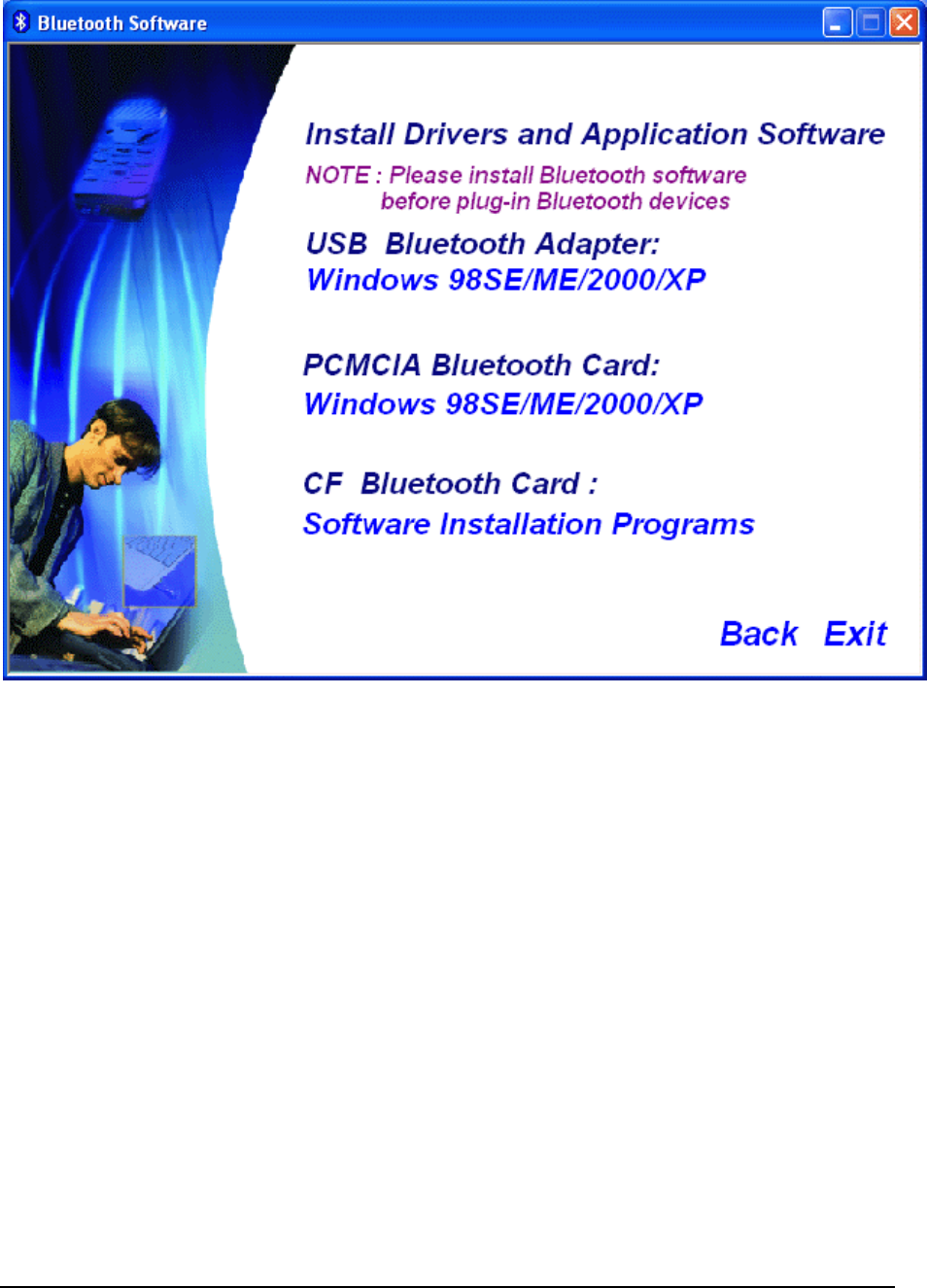
7
(3) Please select your device from the menu.
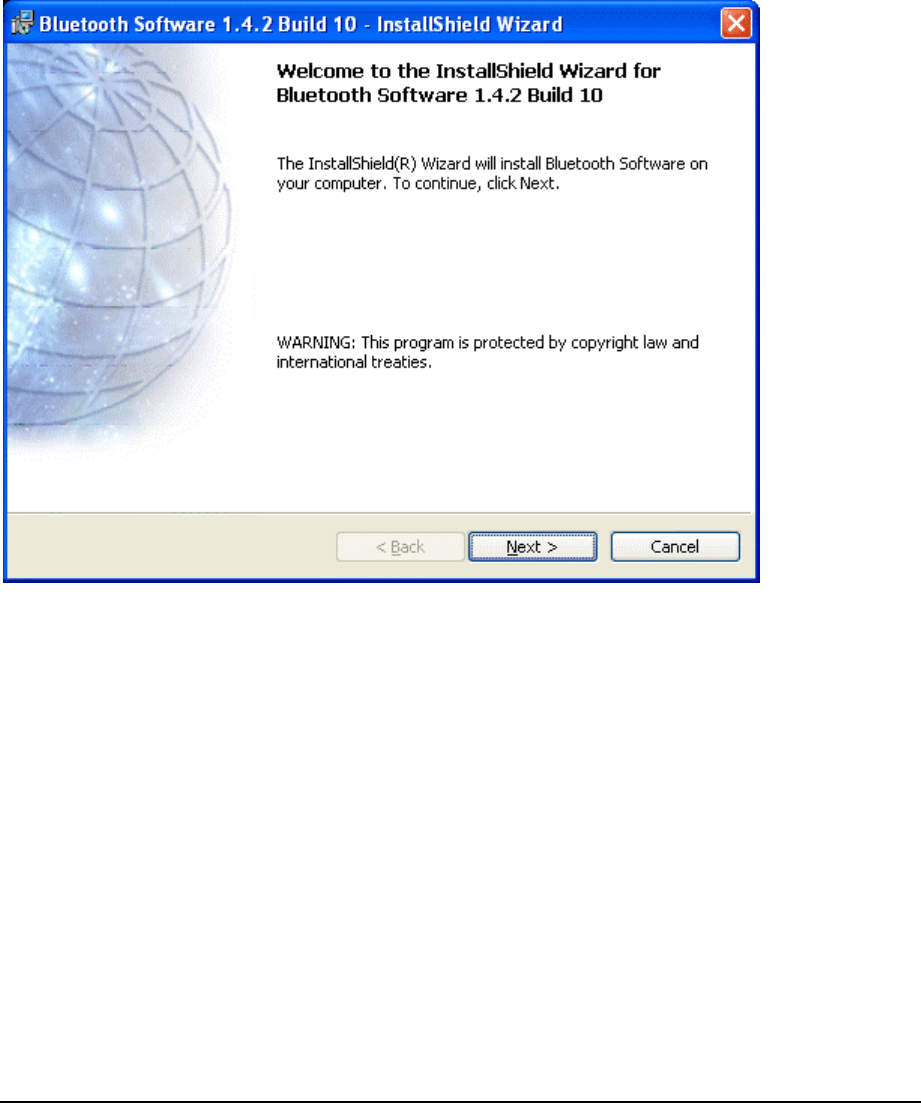
8
(4) Complete the following steps to install Bluetooth software:
(a) Exit all applications.
(b) InstallShield Wizard setup dialog box will automatically be displayed.
(c) Follow the instructions on screen:
(d) On the Welcome screen, click the “Next“ button.
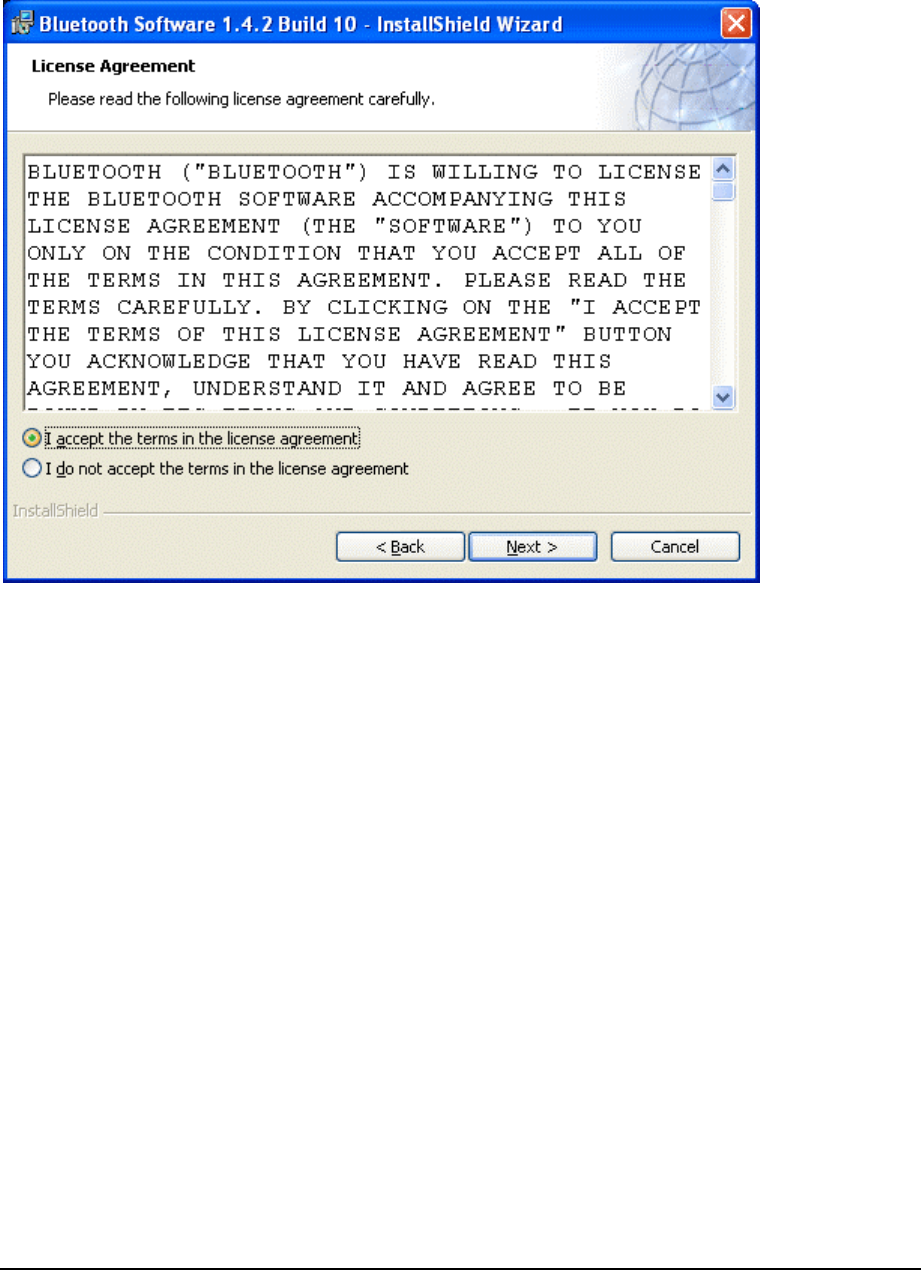
9
(e) When the License Agreement screen is displayed, read the License Agreement, then
click the radio button to the left of "I accept the terms in the license agreement" and
click the “Next“ button.
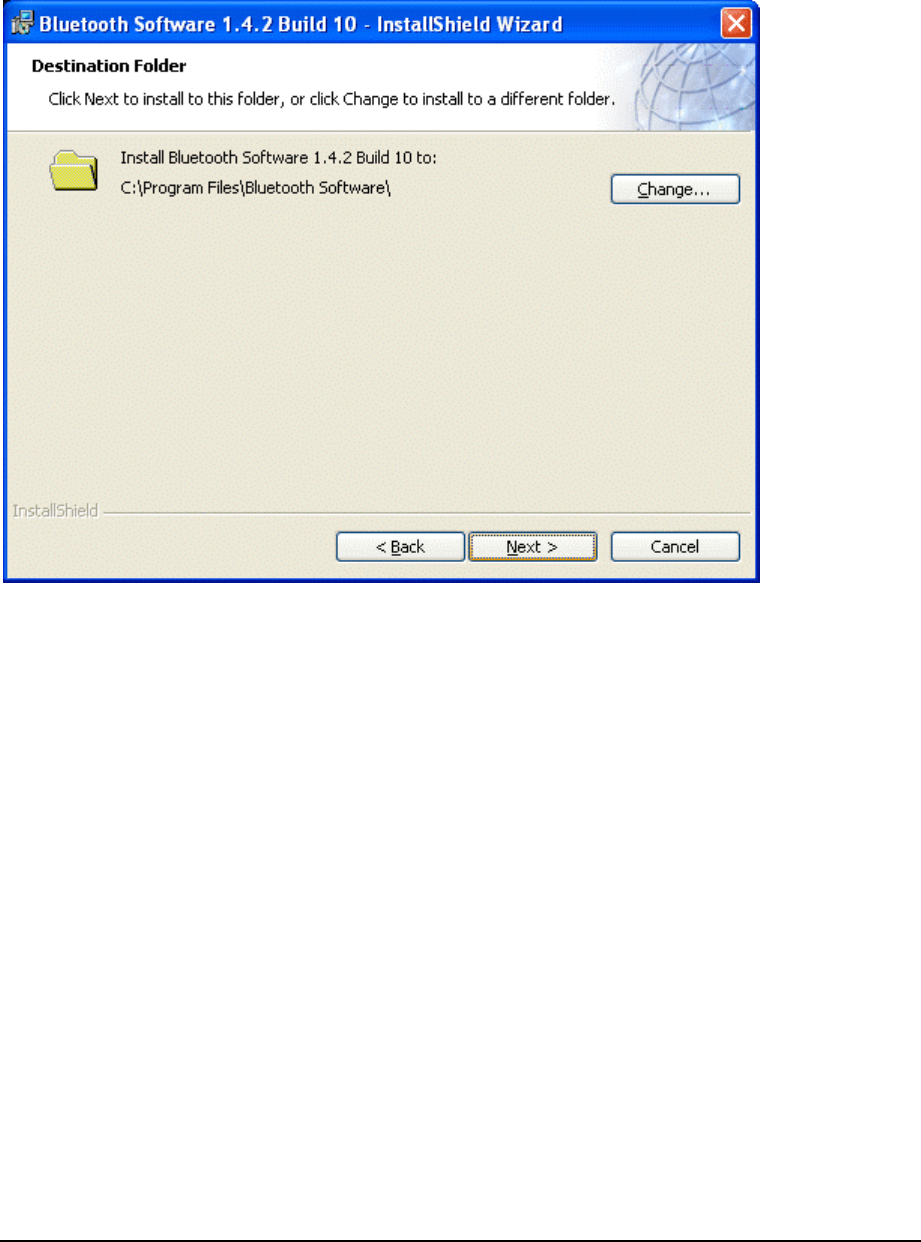
10
(f) You can choose the destination folder in your system, if you do not want to change the
destination folder please click “Next“. On the Destination Folder screen, click the Change
button to browse to a new destination folder for the Bluetooth software. Otherwise, click
the “Next“ button to accept the default folder.
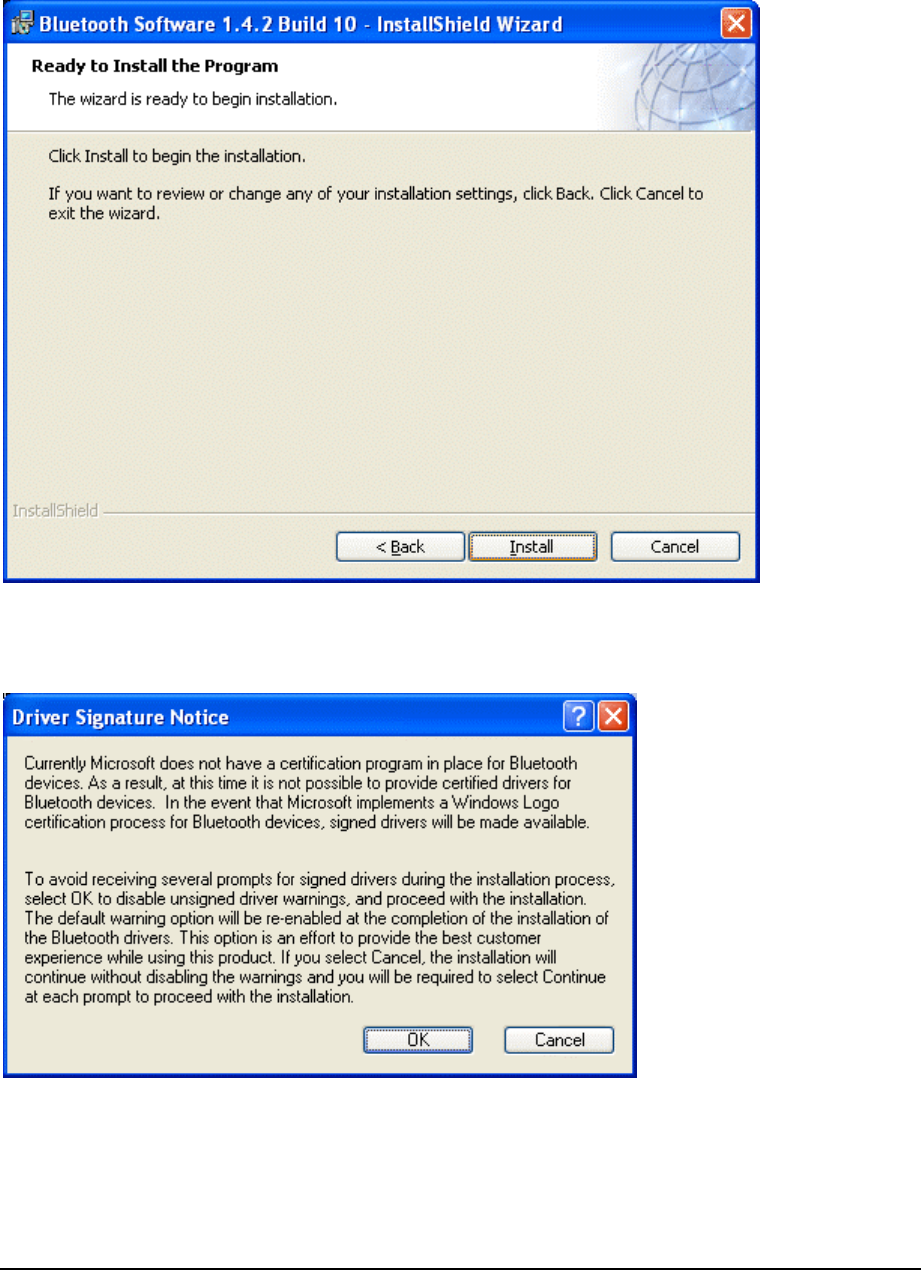
11
(g) The system is ready to install the Bluetooth software. If you need to review or change
any settings, click the "Back" button. Click the "Cancel" button to exit the Wizard.
Otherwise, click the "Install" button.
(h) For Windows 2000/XP users, system will popup a "Driver Signature Notice", please
click the "OK" button.
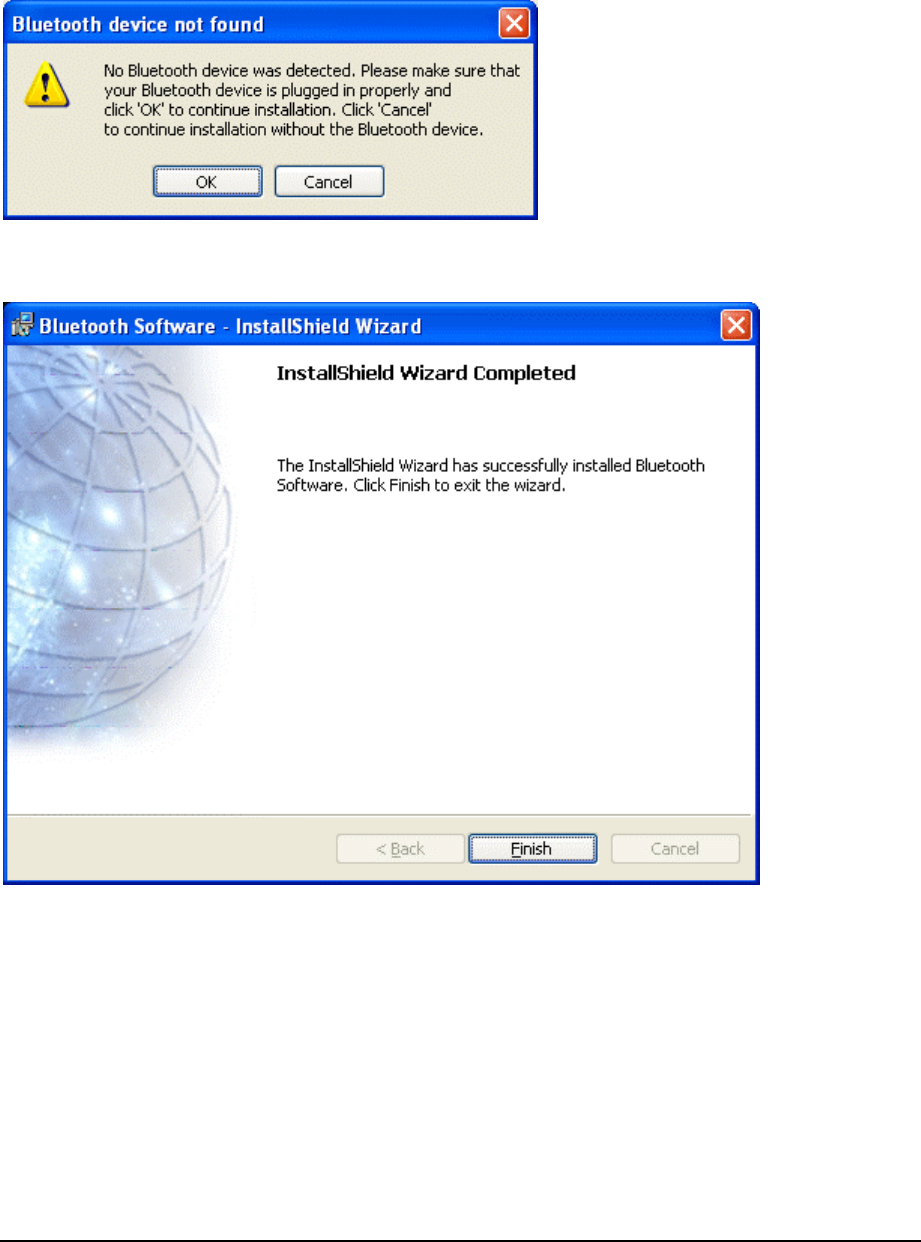
12
(i) During the installation, system will try to detect your Bluetooth device, please plug in
your Bluetooth device when the following message is displayed. Then click "OK" to
continue, or you can click "Cancel" to continue the installation without the Bluetooth
device.
(j) When the installation is completed, please click the "Finish" button.
For more information of Bluetooth software Configuration & User’s Guide,
please refer to Chapter 3 of this application note.

13
Setup for Mac
Mac O.S.X 10.2
Mac O.S. 10.2.x has build-in Bluetooth software for USB Bluetooth adapters, therefore no
additional Bluetooth software is required. Simply plug in the USB Bluetooth adapter and a
Bluetooth icon will appear in the System folder. Open the Bluetooth applet to configure the
Bluetooth functions on your Mac system.
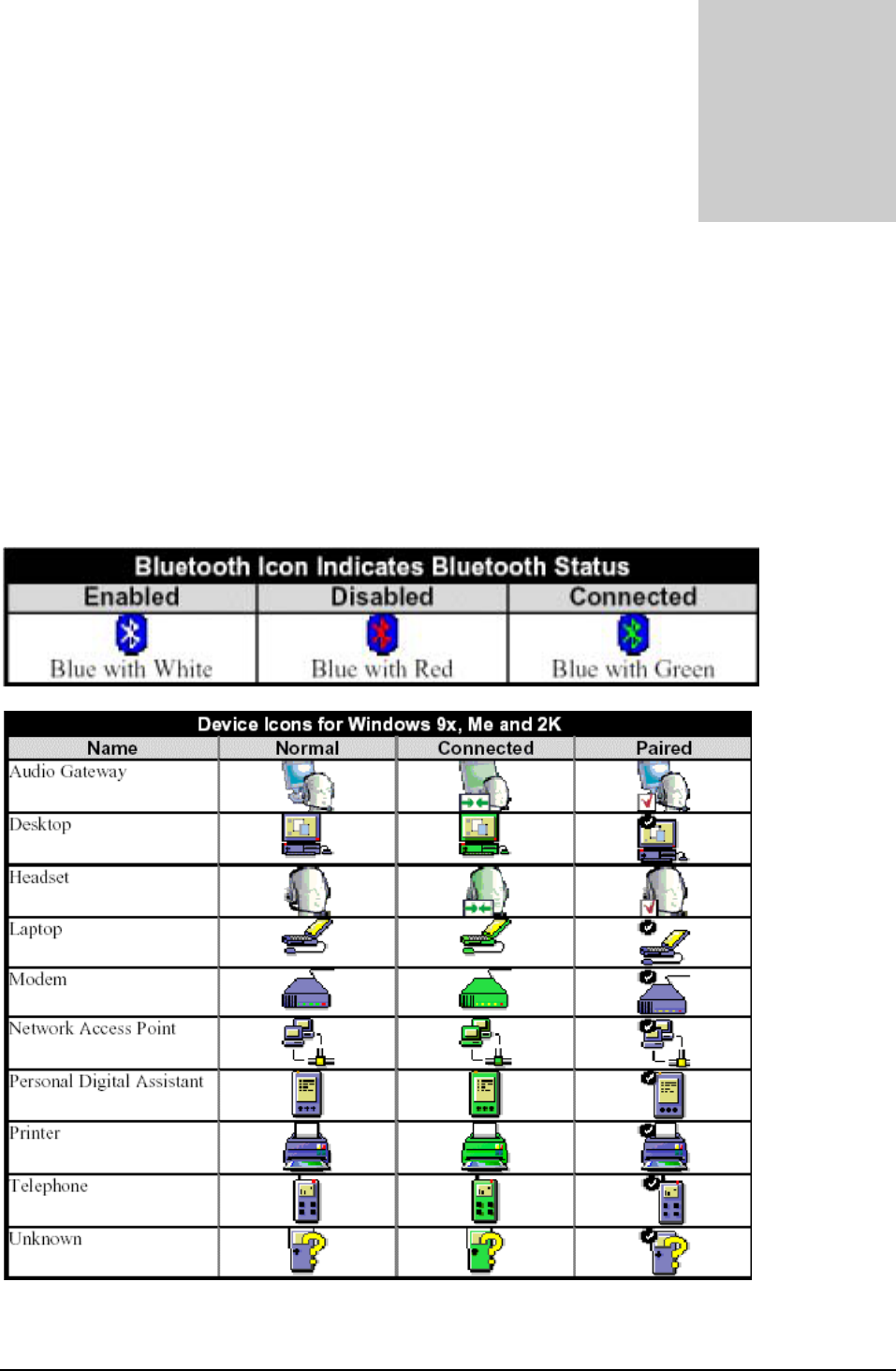
14
Chapter3
Application note for Windows 98SE/ME/2000/XP
3.1 Icons used for Bluetooth devices and services
Bluetooth icons provide at-a-glance feedback about a device or service's status by
changing appearance.
The Bluetooth icon in the Windows system tray provides feedback about Bluetooth status.
Basic Bluetooth Icon
Device Icons for Windows 98SE, Me and 2K
Service Icons for Windows 98SE, Me and 2K
3
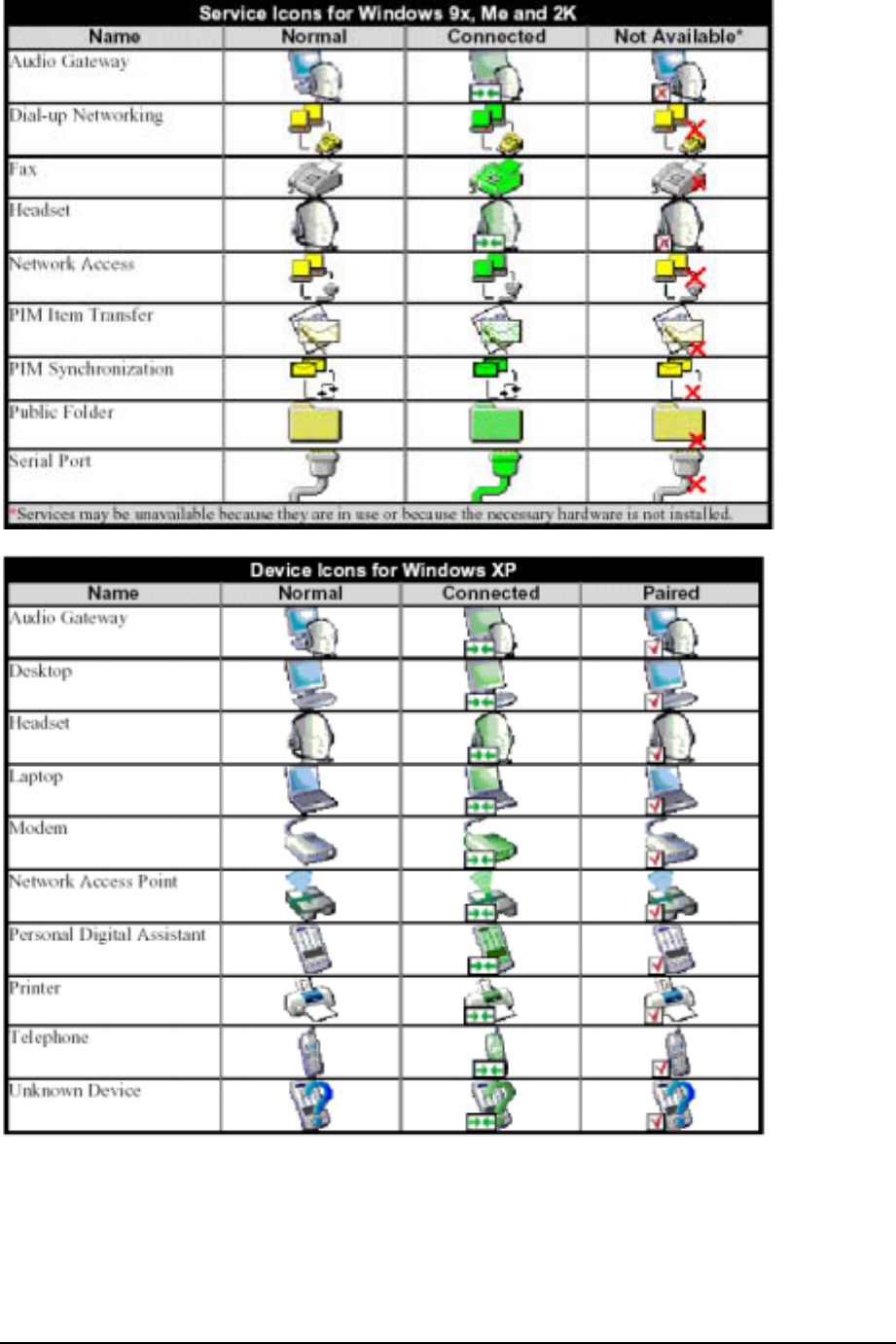
15
Device Icons for Windows XP
Service Icons for Windows XP
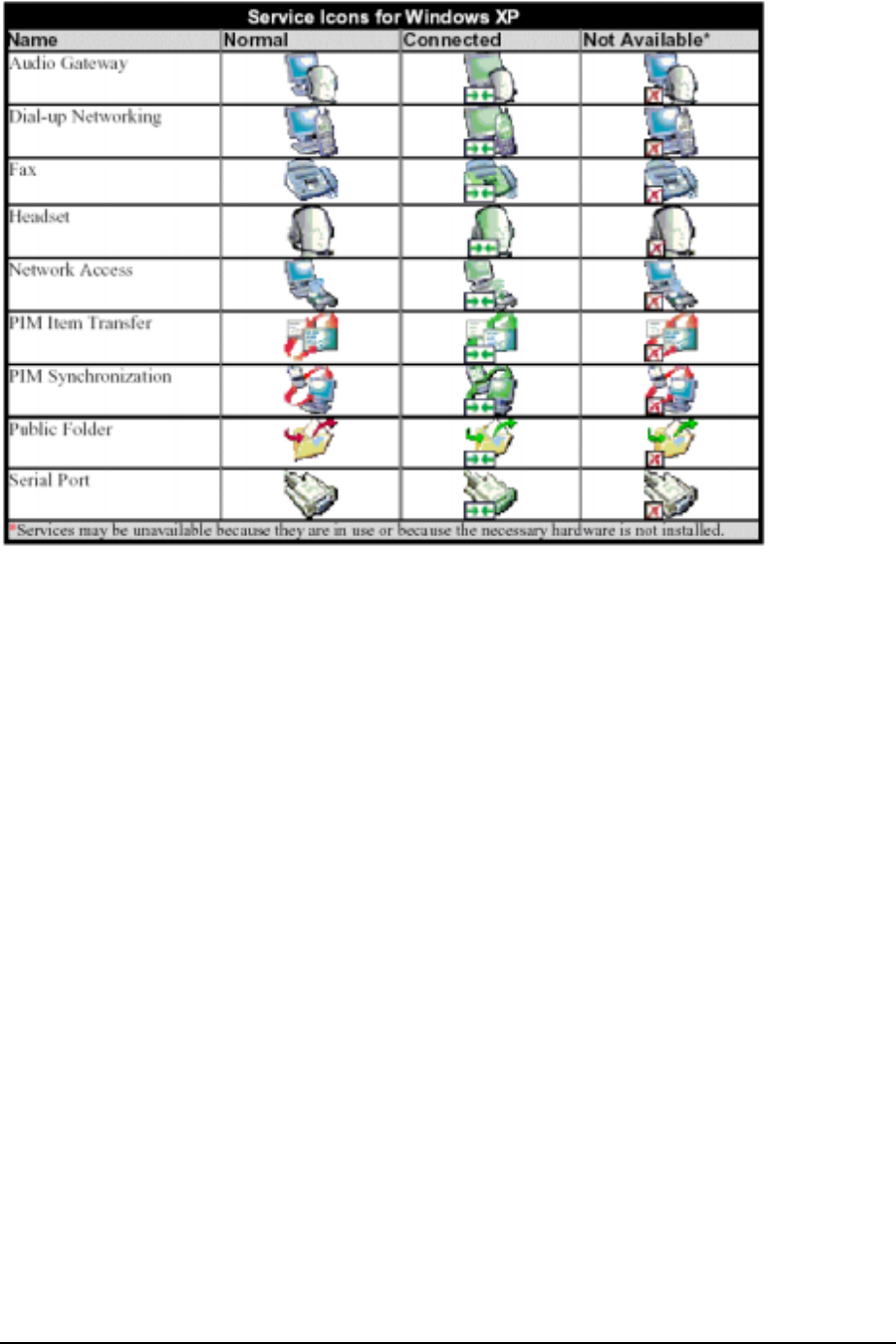
16
NOTE: Only available services are displayed in the menus
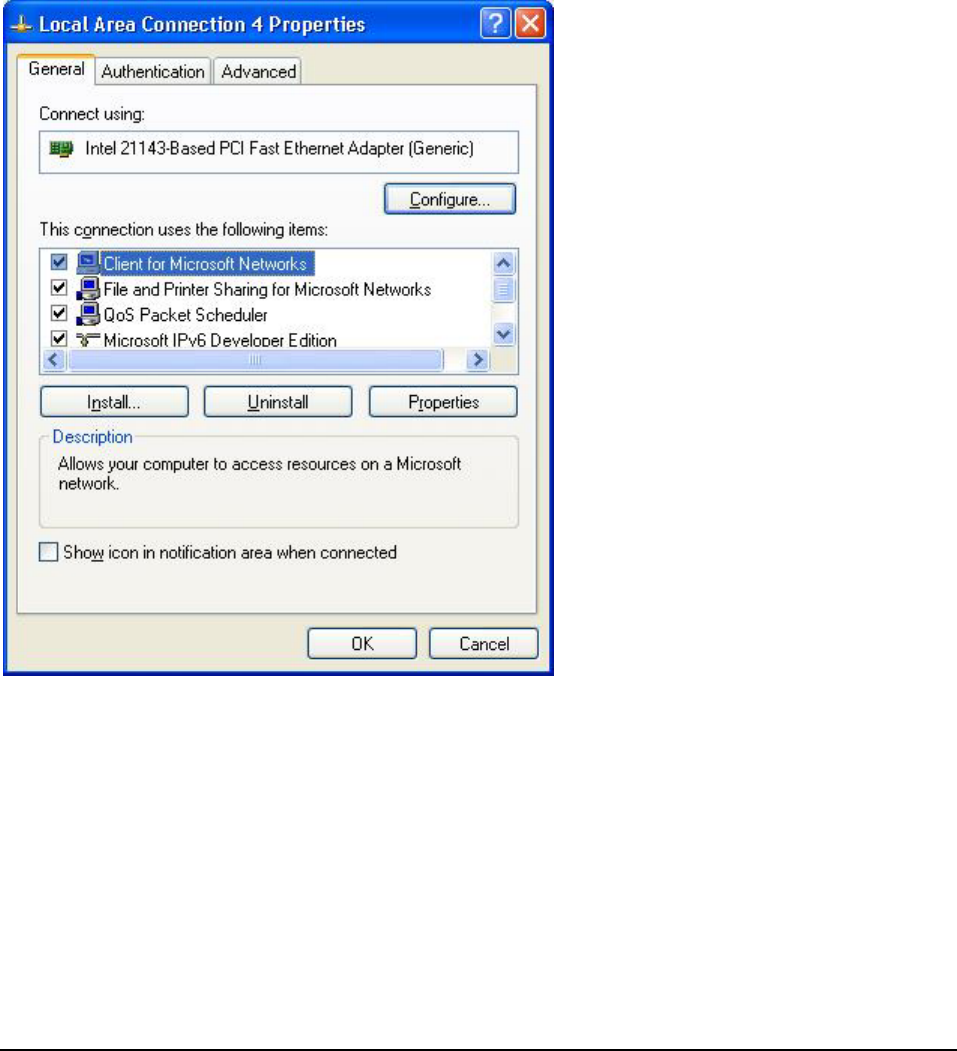
17
3.2. Network sharing setting for Windows
The Network Access service permits a Bluetooth enabled PC (client) to access the
Internet via another Bluetooth enabled PC (Server) that already has an Ethernet
connection.
Windows network sharing setting
PC to PC (Windows 2000 or Windows XP)
1. To enable Internet Connection Sharing on the server PC
2. Click on Start menu-->Settings -->Network and Dial-up Connections and find your
Local Area Connection (LAN) that is connected to the Internet.
3. Right click the active LAN connection to open the "Properties" dialog box.
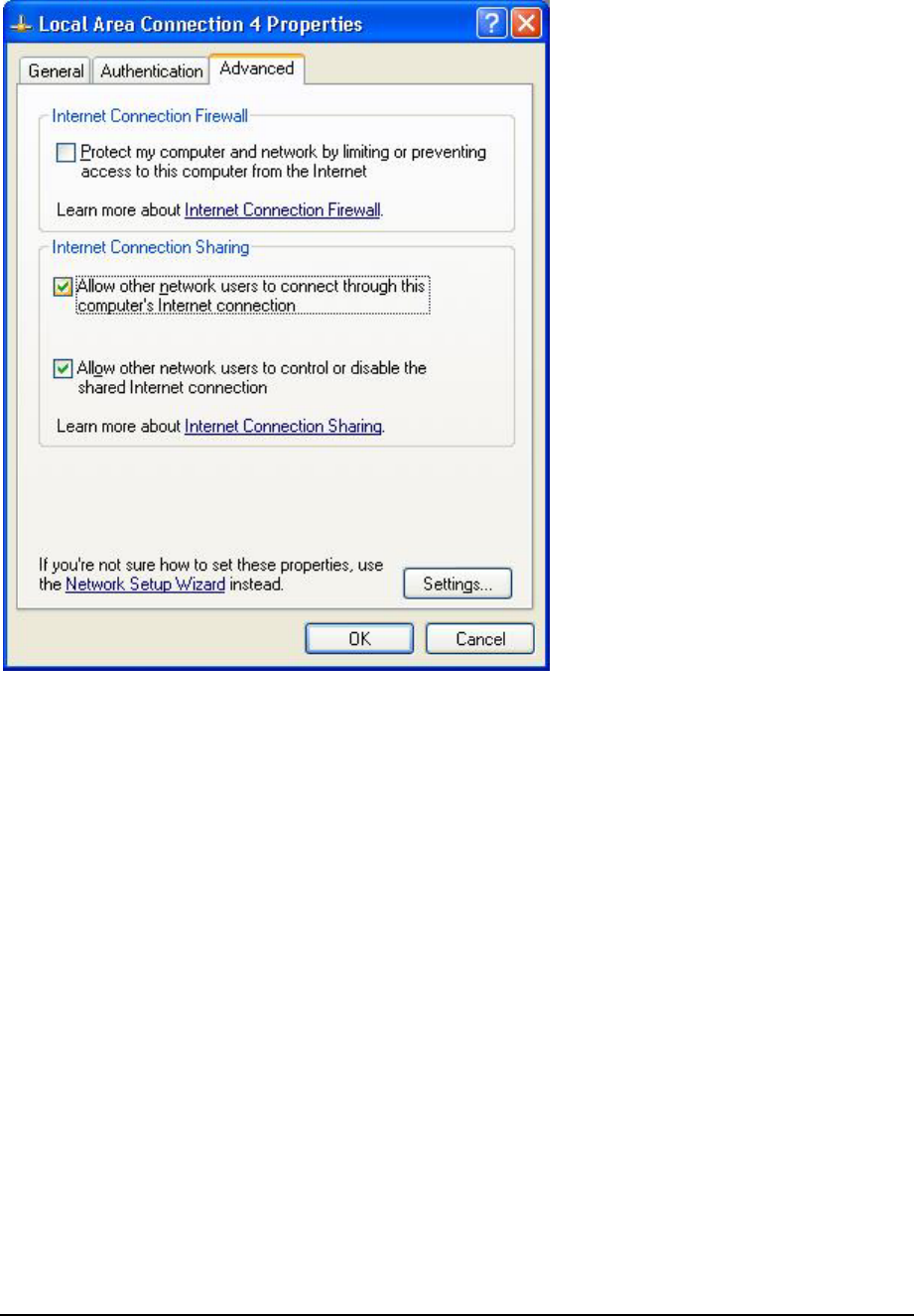
18
4. Click on "Advanced" tab and select the "Internet Connection Sharing" checkbox to
enable Internet sharing.